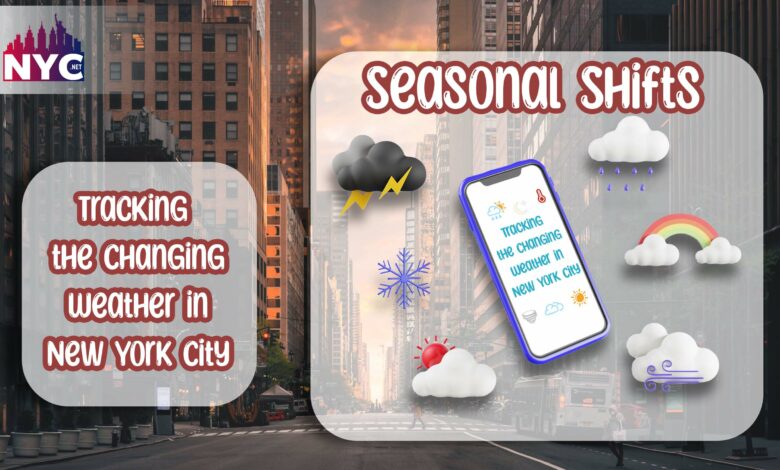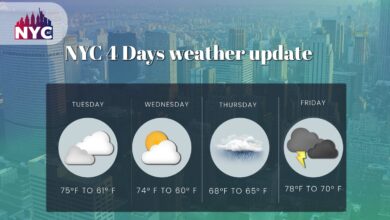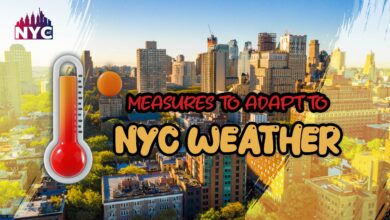Seasonal Shifts: Tracking the Changing Weather in New York City

Weather in New York City
When it comes to the weather in New York City, it is always changing. Therefore, it is crucial to keep track of it. Undeniably, New York City is a bustling metropolis known for its iconic skyline, diverse neighborhoods, and vibrant culture. Additionally, it experiences various weather conditions throughout the year. From hot and humid summers to cold and snowy winters, the city showcases a remarkable display of seasonal shifts that captivates residents and visitors alike.
Tracking the changing weather in New York City provides valuable insights into the city’s climatic variations and helps individuals prepare for the conditions they might encounter.
Hence, with this article, we will try to cover the following subtopics:
- Four Blissful Weather Seasons
- Tracking the Changing Weather
- Importance of Tracking the Weather
- Measures to track the weather
Therefore, without any delay, let’s get into it:
Four Blissful Weather Seaons in New York:
New York City is home to various wonders. Among those wonders resides the blessings of having four blissful weather seasons. Throughout the year, it dresses into different weather attires to give its residents the taste of each.
From blooming sprint to burning summer, cold winter, and fascinating Autumn, there is a treat for each weather.
Hence, here is a brief description of the types of weather in New York City:
Spring: A Burst of Renewal
Firstly, and the most beautiful of seasons, spring. Spring in New York is like a burst of renewal. One can also call it the birth of the human heart. Upon its arrival, it rebirths the city to new favors.
New York City welcomes spring, a season marked by blossoming flowers, longer days, and milder temperatures. Furthermore, In March, the city experiences the:
- an average high temperature of around 50°F (10°C),
- gradually rising to 60°F (15°C) in April
- and further climbing to 70°F (21°C) by May.
However, like any other city, springtime in New York can also be quite unpredictable. You never know when sudden temperature fluctuations and occasional rain showers will come and greet you. Therefore, it is always better to stay cautious. It’s not uncommon to witness New Yorkers shedding their winter coats one day only to bundle up again the next.
During spring, the city’s parks, including the famous Central Park, transform into lush green spaces adorned with blooming cherry blossoms, tulips, and daffodils.
Things to do in Spring:
Undoubtedly, spring brings on a dose of happiness. The refreshing ambiance entices locals and tourists to:
- spend more time outdoors,
- engaging in picnics,
- jogging,
- or simply enjoying a stroll amidst the vibrant foliage.
Summer: The City’s Sizzling Season
The weather in New York City is always changing colors. Just like that, it is summer in the blink of an eye.
As spring transitions into summer, New York City experiences its most scorching weather of the year. The average temperatures range from:
- 80°F (27°C) in June
- to a sweltering 85°F (29°C) in July and August,
Consequently, the city becomes a hotbed of activity. However, the humidity can be quite intense. Hence, residents and visitors must seek relief in air-conditioned spaces or by indulging in ice-cold treats from the numerous street vendors scattered across the city.
Things to do in Summer:
Further, Summer in the city is synonymous with many fun things to do, such as:
- outdoor festivals,
- rooftop parties,
- and trips to the beach.
Moreover, the iconic Coney Island and Rockaway Beach offer respite from the urban heat, attracting crowds of sun-seekers and beach enthusiasts. It’s the perfect time to enjoy a refreshing dip in the Atlantic Ocean or savor a delicious hot dog while basking in the sun.
Hence, Whatever you do, don’t forget to keep yourself safe in the summer!
Autumn: A Colorful Symphony
Moving forward to the weather in New York City, we have Autumn.
The following summer, New York City dons a vibrant coat of red, orange, and golden hues. Autumn, also known as fall, brings cooler temperatures and a spectacle of foliage that blankets the city’s parks and streets.
September ushers in the season with pleasant temperatures hovering around:
- 75°F (24°C),
- gradually cooling down to 60°F (15°C) in October
- and a brisk 50°F (10°C) in November.
Things to do in Autumn:
The final weather in New York City is Autumn
Undoubtedly, it is the epitome of beauty and weather of many fun things.
One of the highlights of Autumn in New York City is the breathtaking transformation of Central Park. The park becomes a tapestry of colors, providing an idyllic backdrop for outdoor activities such as:
- picnics,
- bike rides,
- or peaceful walks along its leaf-strewn pathways.
Fall is also synonymous with pumpkin spice lattes, apple picking, and the highly anticipated Halloween festivities that take over the city.
It is always a fun time to visit New York City.
Winter: A Snowy Wonderland
Finally, it is time for the winter wonderland. New York City’s winter landscape exudes a magical charm immortalized in countless films and songs. From December to February, the city is buried under the coldest temperatures, with average highs ranging from;
- 40°F (4°C) in December
- to around 35°F (2°C) in January and February.
However, The nights can be particularly chilly, often dropping below freezing.
Snowfall is common during winter in New York City. This magnificent miracle beautifully transforms the bustling streets into a winter wonderland. The cityscape is adorned with a pristine white blanket, creating a picturesque backdrop for holiday decorations and festivities.
Winter Wonderland Favors:
- Winter wonderland covers Central Park with heavenly snow. Therefore, it becomes a haven for ice skaters, with the famous Wollman Rink attracting locals and tourists alike.
- Moreover, The city’s iconic landmarks, such as the Rockefeller Center Christmas tree and the window displays on Fifth Avenue, add a touch of magic to the season.
- One can also never get enough of Christmas in New York.
However, winter in New York City is not just about snow-covered streets and holiday cheer. It also brings challenging weather conditions, including blizzards and cold snaps. These events can disrupt everyday life, including:
- transportation systems,
- lead to school closures,
- and require residents to take precautions to stay warm and safe.
Nevertheless, the city looks stunning, dressed in a white gown. However, citizens and tourists should aid with caution in winter.
Tracking Seasonal Shifts: Weather Patterns and Climate Change
Although seasonal changes are new to New York City, climate change has considerably impacted its weather patterns. More frequent and severe heat waves have been observed during summer due to rising global temperatures. Warmer winters have also resulted in less snowfall and shorter ice skating seasons.
The city has taken action to adapt to the changing weather patterns and lessen the effects of climate change. Many Initiatives aim to reduce New York City’s carbon footprint and build resilience against extreme weather events. Some of them include:
- increased green spaces,
- the promotion of sustainable transportation,
- and the implementation of energy-efficient practices
Importance of Tracking the Changing Weather:
Before diving into some measures to track weather in New York, let’s look at the importance.
Tracking the changing weather in New York City is crucial for:
- Residents’ daily planning and understanding of the broader implications of climate change.
- They are essential in providing insights into the city’s weather patterns and enabling proactive measures to respond to changing conditions.
Measures to Track the Changing Weather:
The weather in New York City is already beginning to change due to climate change. Coastal communities, including Red Hook and the Rockaways, are seriously threatened by rising sea levels. Extreme weather events like hurricanes and storms are becoming more frequent and more intense, which has the potential to cause extensive harm and disruption.
In response to these challenges, here are some measures to track the changing weather in New York:
OneNYC plan:
New York City has taken proactive steps to adapt to and mitigate the effects of climate change. The city’s comprehensive sustainability plan, OneNYC, focuses on the following:
- reducing greenhouse gas emissions,
- enhancing resilience,
- And they are promoting environmental justice.
Moreover, many Initiatives are taken to create a more sustainable and climate-resilient city, such as:
- planting millions of trees,
- installing green roofs,
- and improving waterfront infrastructure
Technology Hand in Tracking the Weather:
Furthermore, technology is a vital asset that can be used in the favor of humanity.
Therefore, it also has a major hand in tracking and understanding weather patterns such as:
- Meteorologists can predict changes in weather conditions more accurately because of sophisticated meteorological equipment and weather forecasting models.
- Real-time weather information allows people, emergency response teams, and city planners to decide what to do.
- It also enables them to protect the public and lessen the effects of severe weather occurrences.
Role of Citizens in Tracking the Weather:
Last but not least, New York City’s citizens play an essential role in tracking the changing weather. The idea is for the city to encourage residents to report weather-related observations through various channels, such as
- social media,
- community platforms,
- and official weather monitoring programs.
Doing so provides valuable, localized data that can enhance understanding of weather patterns and contribute to more precise forecasting.
Hence, you must play your part proactively.
Conclusion:
In conclusion, the weather in New York City is unpredictable and has been blessed with blissful conditions. It is always important to stay ahead and cautious of it.
By staying informed and actively participating in weather tracking efforts, residents and visitors alike can;
- contribute to the ongoing dialogue about climate change,
- help shape sustainable policies,
- and ensure a better future for the city they call home.
Hence, We can embrace the seasonal shifts together, understand their significance, and work towards a more sustainable New York City for future generations.



